TOMONOURA; where has been flourished from the ancient times; is a lot of an ancient and honorable origin festivals. Commencing with "Shrine rituals of bow or Otebi (Bonfire)"; which has been registered as intangible ethnic cultural heritage; Kaji-machi (Town Kaji), the historical port town has distinctive yearly events.
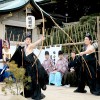
Release an arrow from a bow to purified goblinish of the year and pray for perfect health and good fortune is a prestigious new year's event. This Shrine ritual is came from the historical event that Empress Jingu; who was a wife of Emperor Chuai; dedicated "Izu no Takatomo" (the armour for shooting arrow) to this shrine. It is believed to be has been formed from Hama-yumi (bow) event that pray for new year's calm [More] And this is held by Yawata Shrine as a ritual event. The event is perfectly ritualized (Two days (A day / a day before) event). This has been designed as Fukuyama-city intangible ethnic cultural heritage in 1971.
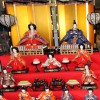
"Tomo / Townscape Doll Festival" turn Tomonomachi spring. In 2012, this event will celebrate 10th anniversary and is taking hold as annual event. The main venue of this event will be held at the following places; "Fukuyama-city Tomonoura Ethnic Historical Museum" and "Tomonotsu Merchant House" and various Dolls will be decorated in this area. By town people's high-level awareness of disaster prevention, townscape in Tomonoura remains as it was. [More] Tomonoura, the port Town of Setouchi Sea. While enjoying graceful dolls decoration, you will walk around and enjoying historical townscape – This is smooch event; signal the coming of Spring.
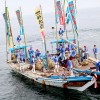
Tomonoura sea beam net-fishing has been held for about 380 years of tradition. This "Tomonoura Tourism net-fishing" recall the traditional fishing method. Madai (Red Seabeam) has come back to Setonai Sea; the birth place; around Cherry Blossoms bloom timing for egg production. And this sea beam net-fishing is waiting for the school of Red sea beam. Chest-thumping drumming and melody of good catch are blended and Otohime; the princess dancing good-catch pray dance on the boat. [More] Sea beam net-fishing tells of arrival of summer in Tomonoura. "Yeah! Ho! Yeah! Ho!" while runs up "good catch" flag, the ship out to the sea. This is gallant!
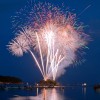
When you hear "Fireworks", you may think of high-summer, however, the fireworks event in Tomonoura will take place around end of Spring or the advent of early summer in Bentenjima's night sky. Because Bentenjima has Benten-do (Fukujyu-do) which enshrine Benzaiten, this small island called "Bentenjima". And approximately 2,000 fireworks are set off from this small island. On the opposite shore, lined with stalls, [More] and will hear merry voice of Sellers from this way and that. Many people are gathering here, this will be exciting night. Proud festival in Tomonourai indicated coming of full summer in Setouchi.
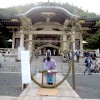
Anecdote of "Fudoki which edited in Nara period became as an annual event to this day is "Chinowa Kuguri". "Summer ritual" had been wrote in Shui Wakashu in Heian period. This shrine ritual will be held on every June 30 at the shrine around the country. To go through Chinowa [More] has been believed to purified their foulness or disaster. Nunakuma Shrine; commonly called "Gion-san"; is also crowded with many people every year.
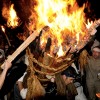
"Otebi Festival" of Tomonoura is known as one of three major Bonfire, along with "Kurama no Himatsuri (Yuki Shrine, Kyoto) and "Nachi no Himatsuri" (Kumano Nachi Shrine, Wakayama). And its origin goes back to premedieval (Origin unknown). In full summer at Nunakuma shrine echo with drumming and solemn chants will take place. In addition, a divine fire that made by flint stone [More] will shifted to Otebi, and a group of Ujiko will carried it to above by taking large stone steps. This red-hot festival will convey what does the mean of an origin of fire to modern people.
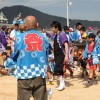
Yodohime shrine is located outside of Nunakuma shrine property where at Myojinsaki; the south side of Tomono port. The view of Tomoe Port from small mound covered by Ubamegashi (Quercus phillyraeoides) is overwhelming and Raisanyo applauded. This festival take place on July 7th in the lunar calendar (The first Saturday and Sunday of August in present), and [More] carry three ‘mikoshi" (portable shrine); Kawaraya, Naka and Tanohira out from the shrine and go round above three places. Therefore people had been called "Taira no Nage Mikoshi".
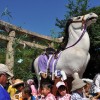
"Hassaku" is abbreviation of August 1st. During "Hassaku seku", various festivals are take place in many parts of nation. In Setouchi, we have been called it as "Uma seku". In "Nakamura family diary" or "Otoijoutousho" edited by Kanchazan; the Confucian of Fukuyama clan wrote that people pull dummy horse, and many people had been visited in Tomonoura for this event. [More] And the size of dummy horse has variation from size of puppy to full-size. And some are fabulously realistic; they are an enjoyable tourist attraction.
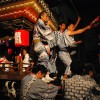
Watasu shrine is located at Nunakuma shrine property. Its festival takes place in a great way from August 11 in the lunar calendar for three days. Watasu shrine enshrine "Oowatatumino mikoto", and according to Manyoushu, he was a sea-god who thrust "seaway peace" belief. And this sea-god will carry to on-duty town in the first day of the festival. [More] And the second day, otabijyo festival held at the on-duty town. On the last day, the sea-god back to the shrine. Only in doing so, villagers are able to do uninhibited ‘Chousai" to start.
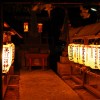
"Fuigo" is a fun that used at Kaji (forge) work. Kaji craft workers have always valued Fuigo. Therefore, steel industry related festivals called "Fuigo Matsuri" (Fuigo festival) nationally. Tomonoura is flourished as ‘Waiting port' from the ancient times, and in Nara period, Kaji work for ship had been developed. In Edo period, steel industry was the major business in Tomonoura. [More] Masanori Fukushima was gathered Kaji craft workers at the North side of the castle and settled Kaji-town when re-build Tomoe castle and create castle town in 1601. And Kogarasu shrine is located at the center of the Kaji town and is enshrine a guardian god of Tomoe kaji